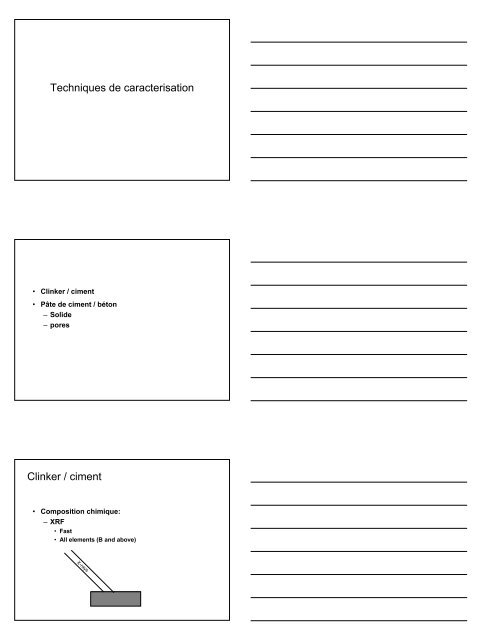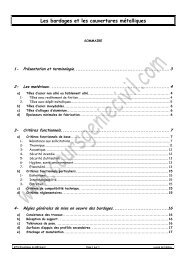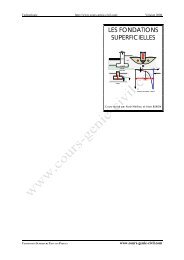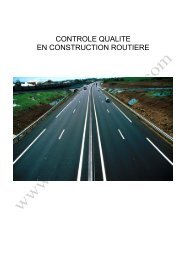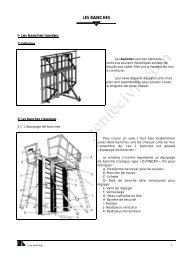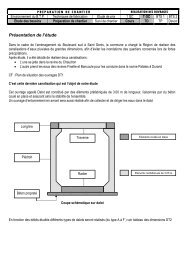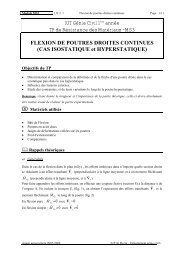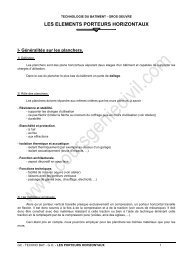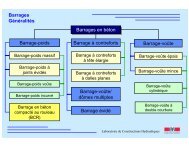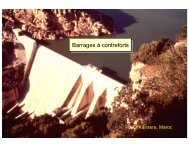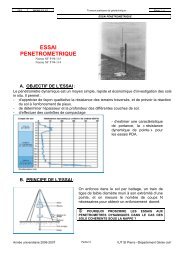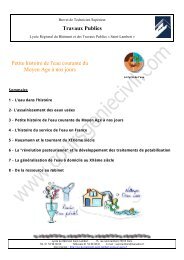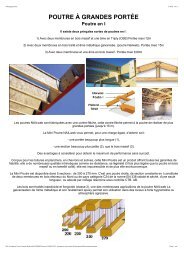Techniques de caracterisation Clinker / ciment - Cours de Génie Civil
Techniques de caracterisation Clinker / ciment - Cours de Génie Civil
Techniques de caracterisation Clinker / ciment - Cours de Génie Civil
Create successful ePaper yourself
Turn your PDF publications into a flip-book with our unique Google optimized e-Paper software.
<strong>Techniques</strong> <strong>de</strong> <strong>caracterisation</strong><br />
• <strong>Clinker</strong> / <strong>ciment</strong><br />
• Pâte <strong>de</strong> <strong>ciment</strong> / béton<br />
– Soli<strong>de</strong><br />
– pores<br />
<strong>Clinker</strong> / <strong>ciment</strong><br />
• Composition chimique:<br />
– XRF<br />
• Fast<br />
• All elements (B and above)<br />
X-rays
20 µm<br />
«alite»<br />
C 3 S, impure<br />
« belite »<br />
C 2 S, impure<br />
phases<br />
«interstitielles»<br />
«celite»<br />
C 3 A, impure<br />
+ solution<br />
soli<strong>de</strong> <strong>de</strong> ferrite<br />
«C 4 AF »,<br />
liqui<strong>de</strong> pendant<br />
la cuisson<br />
X-ray diffraction -Braggs law<br />
Limitations of conventional<br />
quantitative XRD-analysis:<br />
1200<br />
Belite: Influence of the preferred orientation on the peak area<br />
- Preferred orientation effects<br />
- Overlapping of peaks<br />
- Solid solutions<br />
Intensities (counts)<br />
1000<br />
800<br />
600<br />
400<br />
200<br />
0<br />
No orientation<br />
Orientation 0.9<br />
Orientation 0.7<br />
Orientation 0.5<br />
25 30 35 40<br />
2-Theta (°)<br />
Theoretical calculation of a mixture of 50 % Alite and 50 % Belite<br />
Solid solutions<br />
*<br />
Example Alite :<br />
(Ca 0,98 Mg 0,01 Al 0,067 Fe 0,00333 ) 3 (Si 0,97 Al 0,03 )O 5<br />
Similar: Belite, Aluminate and Ferrite<br />
Intensities<br />
600<br />
500<br />
400<br />
300<br />
200<br />
Alite<br />
Belite<br />
*<br />
CEMENT CHEMISTRY, H.F.W. Taylor (2nd edition 1997)<br />
100<br />
0<br />
10 20 30 40 50 60<br />
2-Theta (°)
2500<br />
2000<br />
1500<br />
1000<br />
500<br />
0<br />
2500<br />
2000<br />
1500<br />
1000<br />
500<br />
20 25 30 35 40 45 50 55 60<br />
2-theta<br />
0<br />
SECAR 71<br />
SECAR 71<br />
400<br />
300<br />
200<br />
100<br />
20 25 30 35 40 45 50 55 60<br />
2-theta<br />
0<br />
57.2 wt.-% Alite<br />
18.2 wt.-% Belite<br />
12.2 wt.-% Aluminate<br />
7.1 wt.-% Ferrite<br />
4.4 wt.-% Gypsum<br />
0.9 wt.-% Lime<br />
Observed Intensities<br />
Calculated Intensities<br />
Difference<br />
10 20 30 40 50<br />
2-Theta (°)<br />
Quantitative XRD analysis<br />
Intensité (Cps)<br />
Différentes métho<strong>de</strong>s <strong>de</strong> quantification<br />
C) Métho<strong>de</strong> Rietveld<br />
A) Intensité absolue<br />
500<br />
B) Métho<strong>de</strong> surface pic<br />
18 55<br />
0<br />
X<br />
18.2°<br />
Y<br />
Bruit <strong>de</strong> fond<br />
2-theta (°)<br />
Rietveld working principles<br />
Diffractometer BRAGG: n•λ = 2•d•sin Θ<br />
X-RAY beam<br />
cut out<br />
d<br />
x-ray beam<br />
observed diagram<br />
intensity<br />
pow<strong>de</strong>r<br />
sample<br />
Portland Cement<br />
Intensities (counts)<br />
Atoms / Position X Y Z Occup.<br />
calculated diagram<br />
Mg 2+ 0.000 0.000 0.000 0.1667<br />
C 0.000 0.000 0.000 0.1667<br />
O 1- 0.2800 0.000 0.2500 0.5000<br />
intensity<br />
Lattice parameters 4.6330 6.6330 15.0160<br />
Preliminaries: a) stable running Rietveld software<br />
b) precise working control files<br />
The Rietveld method<br />
<strong>Clinker</strong> Port La Nouvelle<br />
300<br />
Observed Intensities<br />
Calculated Intensities<br />
Difference<br />
Intensities (counts)<br />
200<br />
100<br />
0<br />
10 20 30 40 50 60<br />
2-Theta(°)
1 2 3 4 5 6 7<br />
Weight-%<br />
Content of Alite<br />
80<br />
Samples 1-5:<br />
<strong>Clinker</strong> Type A<br />
75<br />
Samples 6-7:<br />
<strong>Clinker</strong> Type B<br />
70<br />
65<br />
Rietveld calculation<br />
60<br />
Sample X-rayed in Halle<br />
Rietveld calculation<br />
Sample X-rayed at LCR<br />
55<br />
Microscopy CTS<br />
50<br />
Sample No.<br />
Weight-%<br />
Content of Aluminate<br />
12<br />
Rietveld calculation<br />
10<br />
Sample X-rayed in Halle<br />
Rietveld calculation<br />
Sample X-rayed at LCR<br />
8<br />
Microscopy CTS<br />
6<br />
4 Samples 1-5:<br />
<strong>Clinker</strong> Type A<br />
2 Samples 6-7:<br />
<strong>Clinker</strong> Type B<br />
0<br />
1 2 3 4 5 6 7<br />
Sample No.<br />
wt.-%<br />
wt.-%<br />
10<br />
10<br />
8<br />
8<br />
6<br />
6<br />
4<br />
4<br />
2<br />
2<br />
0<br />
0<br />
% gypse dsc<br />
% gypse dsc<br />
% standard<br />
% standard<br />
% gypse rietveld<br />
% gypse rietveld<br />
2 3 4 1 5 6 7 8 9<br />
1 2 3 4 5 6 7 8 9<br />
Samples 1 to 9<br />
Samples 1 to 9<br />
wt.-%<br />
wt.-%<br />
12<br />
12<br />
10<br />
10<br />
8<br />
8<br />
6<br />
6<br />
4<br />
4<br />
2<br />
2<br />
0<br />
0<br />
% sh dsc<br />
% sh dsc<br />
% standard<br />
% standard<br />
% sh rietveld<br />
% sh rietveld<br />
1<br />
1<br />
2<br />
2<br />
3<br />
3<br />
4<br />
4<br />
5<br />
5<br />
6<br />
6<br />
7<br />
7<br />
8<br />
Samples<br />
8<br />
Samples<br />
1<br />
1<br />
to<br />
to<br />
9<br />
9<br />
À cause <strong>de</strong>s solutions soli<strong>de</strong>s<br />
Le calcul « Bogue » n’est qu’une<br />
estimation<br />
C 3 S<br />
BOGUE<br />
59<br />
QXDA<br />
67<br />
C 2 S<br />
C 3 A<br />
«C 4 AF »<br />
13<br />
9<br />
9<br />
15<br />
5<br />
6<br />
Écarts typiques<br />
Pâte <strong>de</strong> <strong>ciment</strong> / béton - solids<br />
Hydrates<br />
• Hydroxi<strong>de</strong>s <strong>de</strong> calcium, Ca(OH) 2<br />
• C-S-H ?
NMR – RMN – resonance magnetic nucleaire<br />
• Nucleus with non-zero magnetic moment<br />
• Strong magnetic field,<br />
strong radio frequency pulse aligns nagnetic<br />
moments<br />
• Magnetic moments relax back to equilibrium<br />
positions<br />
• Fourier transform of time <strong>de</strong>pen<strong>de</strong>ncy ><br />
frequency spectrum<br />
Nuclear Magnetic Resonance : application to<br />
silicates<br />
One chemical environement<br />
→ one chemical shift (in ppm) on the<br />
29 Si MR spectrum<br />
Q 0<br />
Q 1<br />
Q 2<br />
29 Si chemical shift table<br />
(Engelhardt and Michel)<br />
Q 3<br />
Q 0<br />
Cement<br />
Q 4<br />
-60 -70 -80 -90 -100 -110 -120<br />
ppm<br />
Q 3<br />
Q 2<br />
Q 1<br />
Calcium Silicate<br />
Hydrates<br />
Quartz, silica<br />
fume<br />
Q 4<br />
Characterisation of <strong>ciment</strong> : 29 Si spectrum<br />
Q 1<br />
C-S-H<br />
Q 2<br />
Q 2p<br />
cement<br />
sand and quartz Q 4<br />
Q 0<br />
-140<br />
silica fume Q 4<br />
-40<br />
-50<br />
-60<br />
-70<br />
-80<br />
-90<br />
-100<br />
-110<br />
-120<br />
-130<br />
(ppm)
NMR<br />
Q2(1Al) indicates Al in<br />
C-S-H chains<br />
120<br />
100<br />
80<br />
Q 2 (1Al)<br />
Q 0<br />
Q 1<br />
Q 2 (0Al)<br />
x10 3<br />
60<br />
40<br />
20<br />
0<br />
-50<br />
-60<br />
-70<br />
-80<br />
-90<br />
ppm<br />
-100<br />
-110<br />
Al subsituting for Si<br />
in bridging sites<br />
-120<br />
9/17<br />
Aluminium in concretes : charactérisation<br />
by using 27 Al NMR<br />
Al IV<br />
cement *<br />
140<br />
120 100 80 60 40 20 0<br />
(ppm)<br />
-20<br />
-40<br />
-60<br />
* = rotating si<strong>de</strong> bands<br />
C-S-H<br />
Aluminium in concretes : charactérisation<br />
by using 27 Al NMR<br />
Si<br />
ettringite<br />
Ca<br />
AFm<br />
Al V<br />
Al IV<br />
paste : water +<br />
cement<br />
140<br />
*<br />
120 100 80 60 40 20 0<br />
(ppm)<br />
*<br />
*<br />
-20<br />
-40<br />
-60<br />
* = rotating si<strong>de</strong> bands
Sections polie, electron retrodiffusé<br />
pores<br />
sand (aggregate)<br />
“outer” or<br />
“undifferentiated”<br />
C-S-H<br />
“inner” C-S-H<br />
partially reacted<br />
cement grain<br />
calcium hydroxi<strong>de</strong><br />
(CH)<br />
Many microanalyses in precise locations<br />
Outer C-S-H :<br />
C-S-H formed<br />
outsi<strong>de</strong> the largest<br />
cement grains.<br />
Inner C-S-H :<br />
C-S-H formed within<br />
the boundaries of the<br />
former cement grains.<br />
EXAMPLE<br />
mechanism of expansion<br />
of mortars cured at elevated<br />
temperatures<br />
0.2<br />
Non-expanding mortar<br />
S/Ca<br />
0.15<br />
0.1<br />
0.05<br />
0<br />
After heating<br />
After 200 days<br />
0 0.05 0.1 0.15 0.2<br />
Al/Ca<br />
S/Ca<br />
0.2<br />
0.15<br />
0.1<br />
0.05<br />
0<br />
Expanding mortar<br />
After heating<br />
After 200 days<br />
0 0.05 0.1 0.15 0.2<br />
Al/Ca
Overall reaction<br />
• Heat output – calorimetry<br />
SO 3 =2.6; C 3 A=10<br />
SO 3 /C 3 A=0.88<br />
SO 3 =3.1; C 3 A=12.1<br />
SO 3 /C 3 A=0.87<br />
SO 3 =2.2; C 3 A=10.1<br />
SO 3 /C 3 A=0.73<br />
Overall reaction<br />
• Heat output – calorimetry<br />
• Bound water<br />
weight loss 110°C – 800 °C


